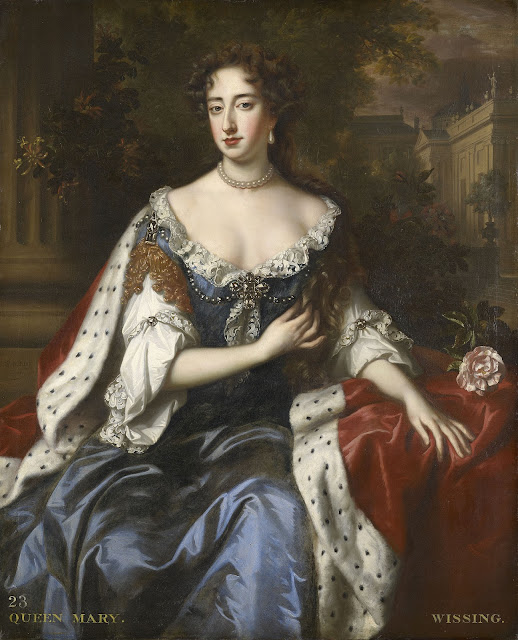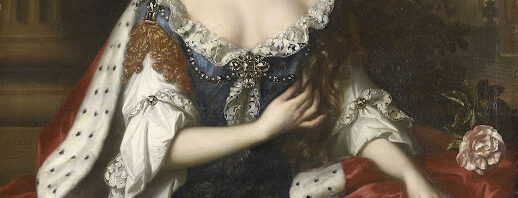 |
| Willem Wissing (1656-87) – Mary II (1662-94) when Princess of Orange c.1686-87 (Photo: Royal Collection Trust RCIN 405643) |
A Choral Celebration of Queen Mary II: Clarke, Blow, Purcell, Handel; chapel choir of the Royal Hospital Chelsea, the Old Royal Naval College Trinity Laban Chapel Choir, Brandenburg Baroque Soloists, Ralph Allwood, William Vann; Chapel of St Peter and St Paul, Old Royal Naval College
Reviewed 30 April 2024
A celebration of Queen Mary II’s birthday brings together the choirs of two institution she was instrumental in founding, mixing professionals with students to create a choral sound full of vigour, energy and joy
Queen Mary II was born on 30 April 1662 so what better way to celebrate her than to bring together the choirs of two institutions that she was instrumental in founding. So, on 30 April 2024, the Chapel Choir of the Royal Hospital Chelsea and the Old Royal Naval College Trinity Laban Chapel Choir under their conductors Ralph Allwood and William Vann came together with the Brandenburg Baroque Soloists in the chapel of St Peter and St Paul at the Old Royal Naval College for a programme of music celebrating Queen Mary II including John Blow’s The Lord God is a sun and a shield, Purcell’s Come, ye sons of art and music from the Queen’s funeral, and Handel’s Utrecht Te Deum.
The venue, the chapel in the Old Royall Naval College is part of Sir Christopher Wren’s original buildings for what was then the Royal Hospital for Seamen but a fire in the later 18th century means that the interior is by James ‘Athenian’ Stuart, creating rather a different atmosphere with its spectacular altarpiece painted by Benjamin West.
The Old Royal Naval College Trinity Laban Chapel Choir, director Ralph Allwood, numbering something over 20 singers, performs services as part of the Chapel’s regular worship and is made up of students from Trinity Laban Conservatoire, which is now based in the historic Old Royal Naval College buildings. The Royal Hospital Chapel Choir, director William Vann, numbering some 12 singers, is a professional adult choir that sings Choral Matins in the Royal Hospital Chelsea’s Wren-designed chapel each Sunday. They were accompanied by the Brandenburg Baroque Soloists, a period instrument ensemble with single strings, oboes, bassoon, trumpets and drums, plus Jonathan Eyre on organ continuo. The two conductors alternated duties during the evening.
Soloists were all drawn from the choirs, which gave us a chance to hear a wide range of voices from seasoned professionals to younger students, all bringing something individual to the performance. This meant that not every performance was perhaps stylishly apposite, but there was great joy in experiencing the way all took part in their own way. I think all 12 members of the Royal Hospital Chelsea choir had a solo and around a dozen or so from the Old Royal Naval College choir.
We began with the well-known Prince of Denmark’s March by Jeremiah Clarke, the first organist of the rebuilt St Paul’s Cathedral, conducted by Ralph Allwood, and it was lovely to hear it in a vivid instrumental performance rather than on the organ.
There followed music from the Coronation of William II and Mary II in 1689, John Blow’s substantial anthem The Lord is a sun and shield (conducted by William Vann), a five-movement work that alternated chorus and solo trio (alto, tenor and bass) with the trio treated more as a semi-chorus (here sung by three members of the Chelsea choir). After a short but vigorous instrumental introduction we were able to hear the terrific full sound that the two choirs made. The work was interestingly complex, rather sober yet with full of great detail in both chorus and instrumental parts, and I loved the way that Blow used his solo forces as contrast to the full ensemble.
Next Ralph Allwood conducted the solo, ‘Vouchsafe, O Lord, to keep us this day without sin’ from Purcell’s Te Deum Laudamus in D, written for the Saint Cecilia’s Day celebration in 1694 and sung by a countertenor from the Greenwich choir. This was a short, sober piece displaying the countertenor’s lovely rich, warm sound to perfection in a finely intent performance.
Purcell’s Birthday Ode for Queen Mary ‘Come, ye sons of art’ from 1694 came next (conductor Ralph Allwood). This was the sixth and final birthday ode that Purcell composer for Queen Mary and in many ways it is the finest. The symphony featured some strong instrumental colours and terrific trumpet playing and Allwood gave the nice feel of a slow dance to the opening chorus featuring a fine soft-grained countertenor solo. The chorus here and elsewhere was wonderfully vivid, with plenty of vigour and strong, upfront sound. ‘Sound the trumpet’ featured two finely balanced mezzo-sopranos, bringing great enjoyment to the duet, whilst ‘Strike the viol’ was sung by a characterful contralto, plangent in tone with a lovely lower range. ‘Bid the virtues’ was sung with vigour and swagger, particularly in the runs, by the bass soloist. We ended with full toned chorus, complete with trumpets and drums. A terrific noise.
Next came a sequence of music from Queen Mary’s funeral of 1695 (conductor Ralph Allwood). First a drum solo, leading into The Queen’s Farewell, a short but touching instrumental piece by Thomas Tollett, performed by oboes and bassoon. Then one of Purcell’s funeral sentences, Man that is Born of Woman in a sober and thoughtful performance with a lovely, very present sound from the choir. Then Purcell’s Funeral March, a simple piece yet one that is wonderfully effective, then another funeral sentence, Thou Knowest, Lord, the secrets of our hearts which began with some lovely hushed singing whilst the strong climax led directly into a crisply rhythmic account of Purcell’s instrumental Canzona.
The final work represented a looking back and a looking forward. William Vann conducted the Te Deum Laudamus that George Frideric Handel wrote in 1713 for Queen Mary’s sister and successor, Queen Anne. The music representing the future of English state music but also Handel’s perspicacity in picking up elements of Purcell’s state style. Though technically in some 29 sections, what we effectively get is a fluidly flowing sequence of chorus, solo and solo ensembles very much in the manner of Purcell’s larger scale works.
There were well over 30 solo opportunities with some people coming forward to deliver a solo and others taking part from the choir, all were relatively short moments yet each was strongly coloured and often vivid. Throughout the choral sound was gloriously strong and present, often with a terrific energy with the solo moments acting as a nice contrast. Two sopranos brough a lovely bright energy to their duet ‘To thee Cherubin and Seraphin’ whilst the sequence from ‘The glorious company of the apostles’ featured a series of strong, intense and vivid short solos. ‘When though hadst overcome’ featured fine, unaccompanied solo quartet whilst the strong solo voices in ‘We believe that thou shalt come’ were accompanied by a stylish flute solo. The two tenors from the Chelsea choir gave us a vibrant yet intense duet, ‘Vouchsafe, O Lord’.
When the trumpets and drums joined in, such as in the chorus ‘Day by day we magnify thee’ the result was a joyous noise. There were plenty of fugal moments for the choir, executed with energy, and enjoyment, and we ended with a particularly vigorous fugue with some brilliant moments.
Throughout the instrumental ensemble accompanied with style and strength, the five string players more than pulling their weight giving us good strong lines, whilst cellist Johnny Byers did sterling work on the continuo.
Never miss out on future posts by following us
The blog is free, but I’d be delighted if you were to show your appreciation by buying me a coffee.
Elsewhere on this blog
- A neglected gem revived: New Sussex Opera in Lampe’s The Dragon of Wantley combining historic style and 1980s politics – opera review
- Lobesgesang: Mendelssohn’s rarely performed symphony-cantata is a fine climax to Sir Andras Schiff and the OAE’s exploration of the composer’s symphonic music – concert review
- Fear no more: Brindley Sherratt on releasing his first recital disc – interview
- A German in Venice: Schütz alongside music he could have heard in Venice, a wonderfully life-affirming disc – record review
- Attention must be paid: the Engegård Quartet at Conway Hall in Mozart, Bartok, Maja Ratkje, and Fanny Mendelssohn – concert review
- Opera as it ought to be: Mozart’s Don Giovanni from Hurn Court Opera reviewed by James McConnachie – opera review
- Leeds Lieder 2024
- A Leeds Songbook and a showcase performance: Leeds Lieder Young Artists 2024 – concert review
- A day of French song with a focus on Fauré, with Graham Johnson making us love the composer’s late period, and James Gilchrist in fine form – concert review
- Engaging the audience: James Newby and Joseph Middleton in a folk-inspired programme at a cool Leeds café/bar – concert review
- The sound of an image: recent chamber music by New York City-based, Puerto Rican-born composer Gabriel Vicéns – record review
- A City Full of Stories: Anna Phillips on her work with Academy of St Martin in the Fields’ SoundWalk – guest posting
- Energy, discipline, & sheer love of music-making: National Youth Orchestra & National Youth Brass Band in Gavin Higgins – concert review
- No boundaries or rules: Yorkshire-based Paradox Orchestra is reinventing the orchestral concert – interview
- Home










